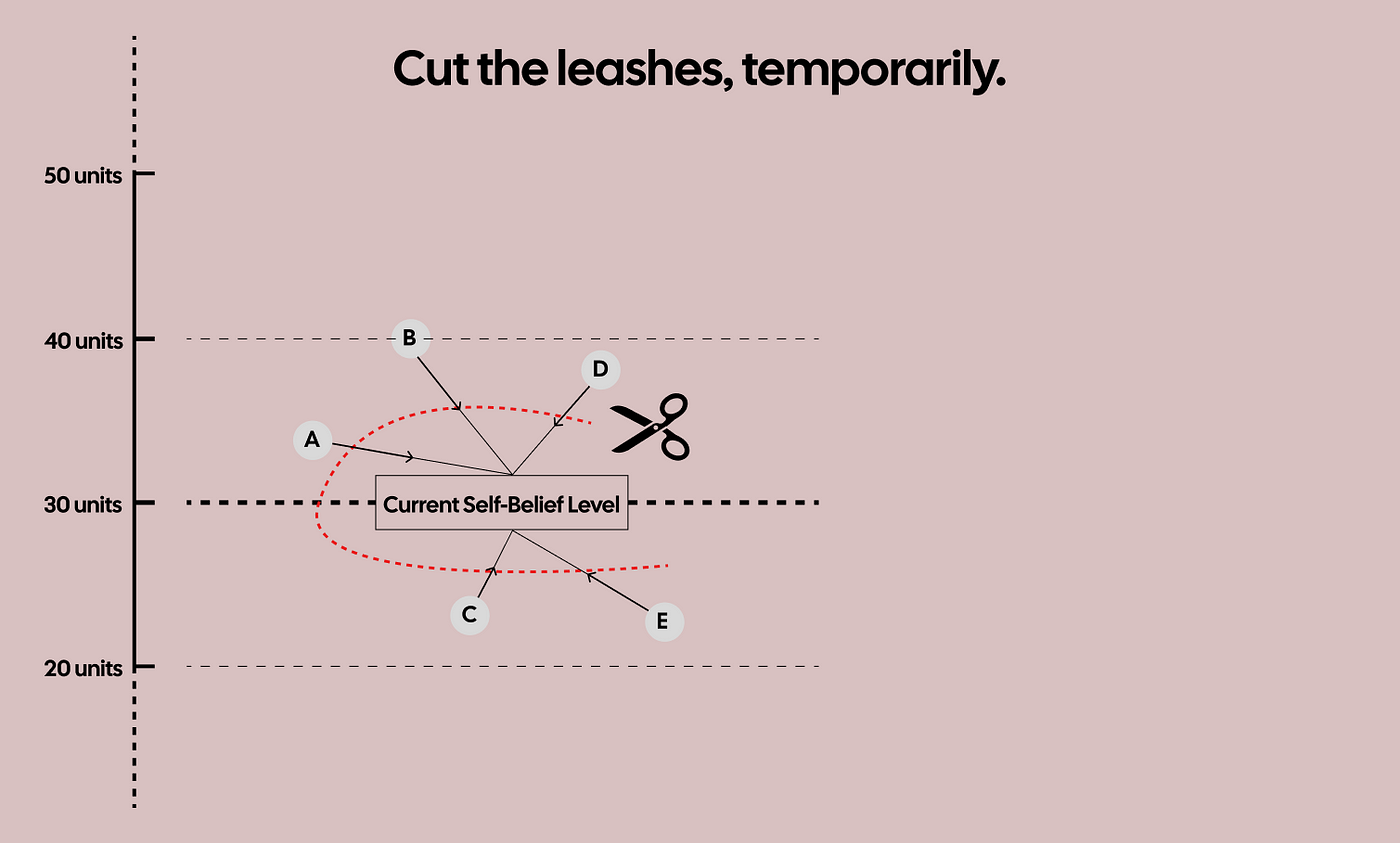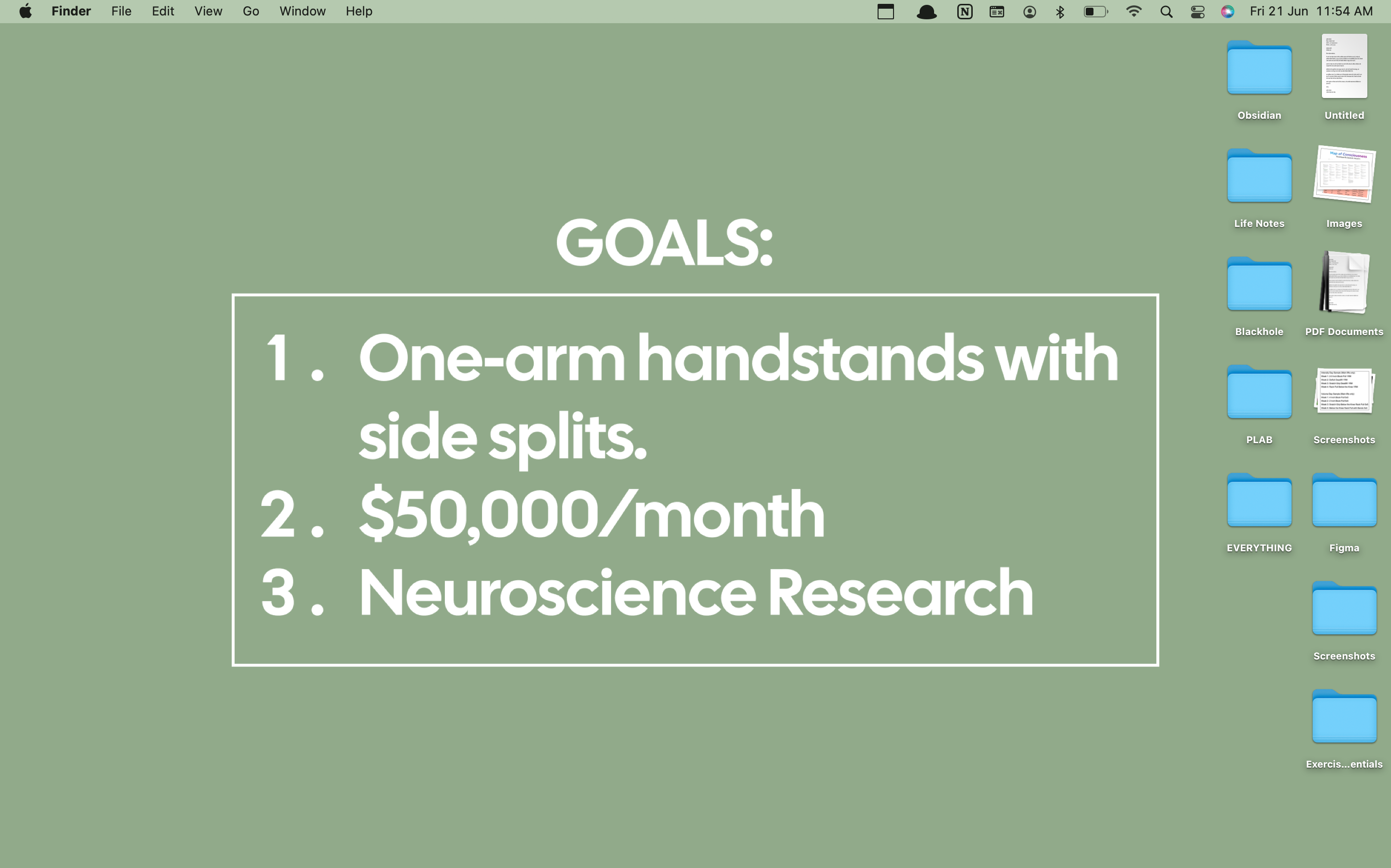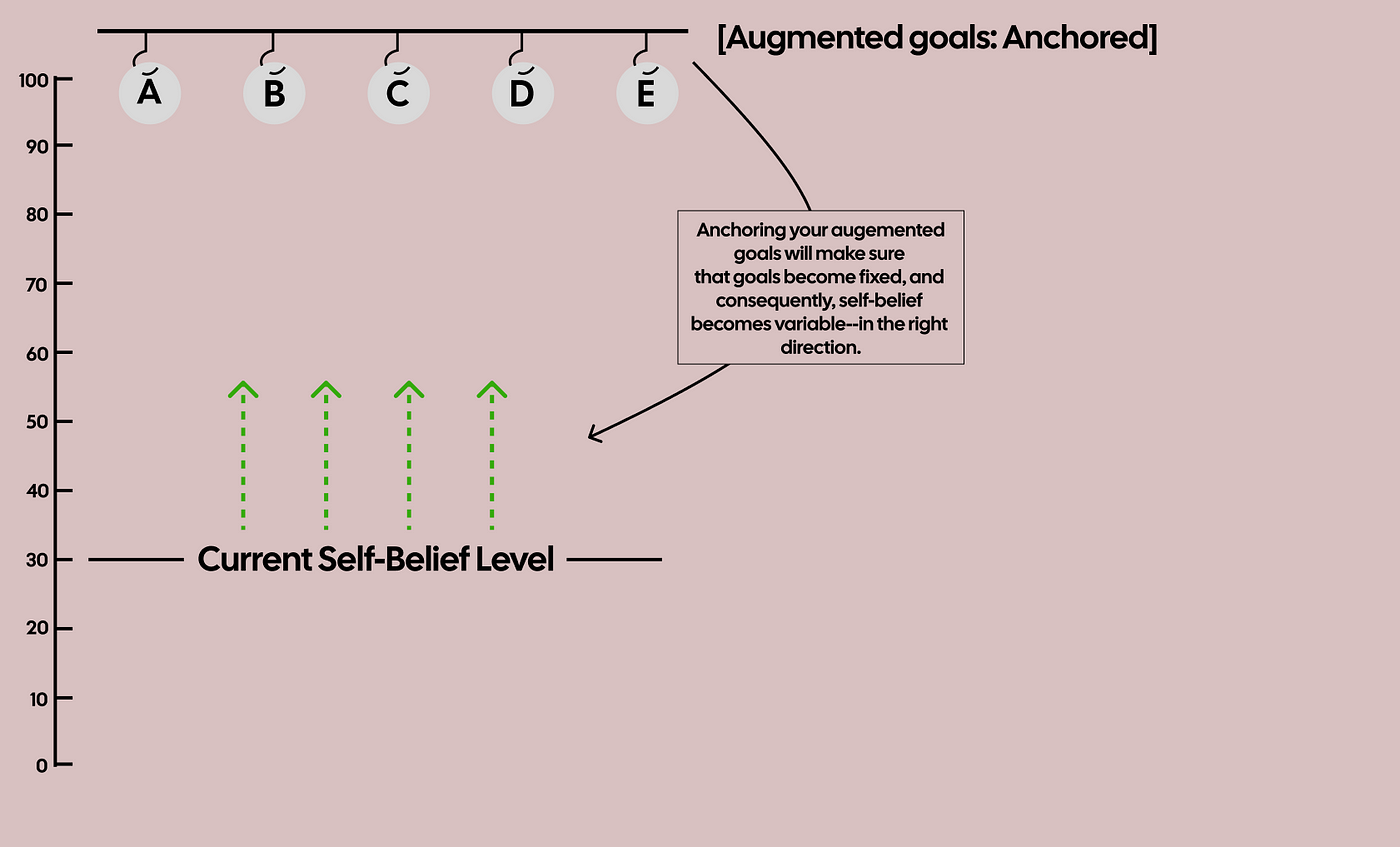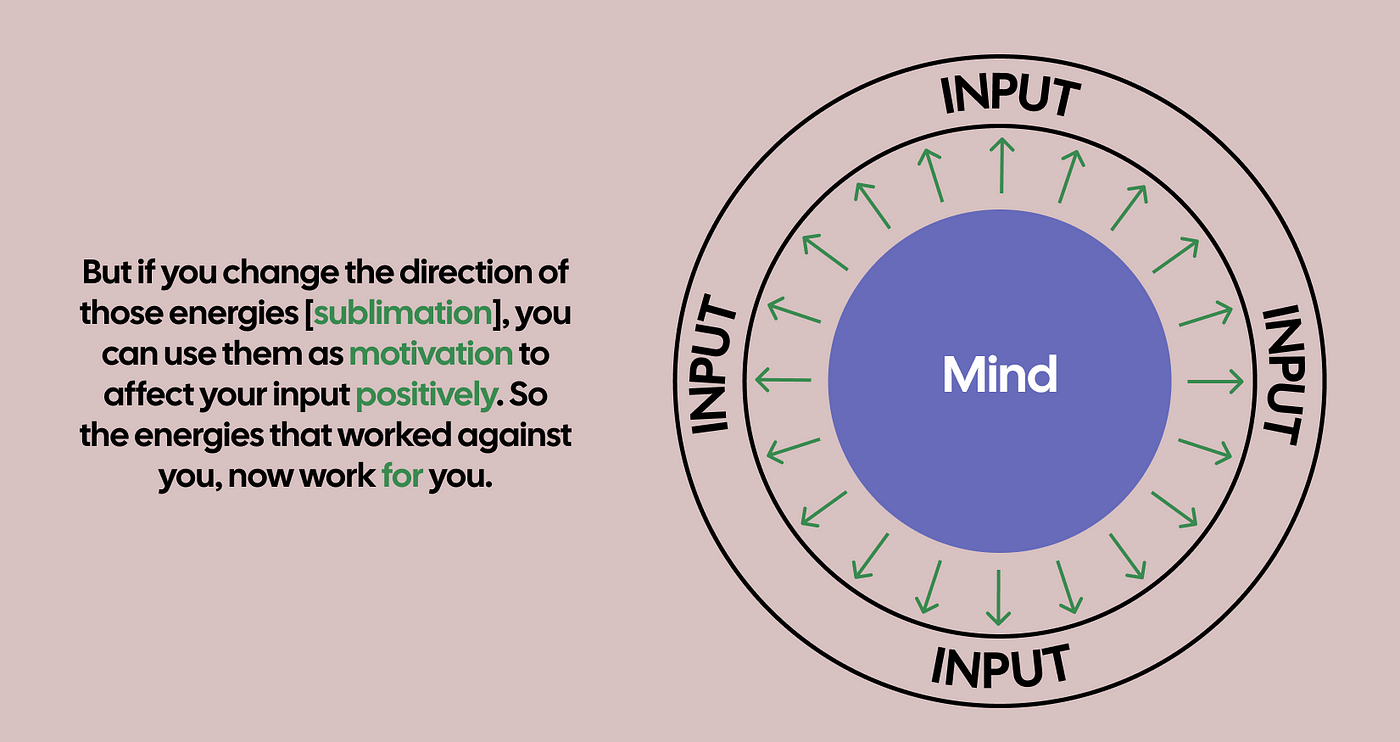- Antifragile Productivity
- Posts
- Try This Life Transforming Goal-Setting Process
Try This Life Transforming Goal-Setting Process

You may not realize this yet, but unknowingly, you might be sabotaging your success, and severely handicapping your potential due to a corrupted goal-setting process.
The key word here is “unknowingly”.
Your goals shape your whole life. They decide:
your daily habits.
who you’ll become.
what you’ll achieve.
And the impact you’ll have on the world.
But… the problem is that our goal-setting process isn’t pure. It’s hindered.
This is because our present self — who often lacks self-belief — is tasked with defining our future goals. So a process that should be pure and fearless, becomes corrupted.
When asked how limiting beliefs impact a person, Kobe Bryant said in an interview: “Dreams should be pure. I think a lot of times we’re born in this world, we actually wind up going backward. It seems like the more we mature, the more responsible our dreams become, and the more governors we put on ourselves and our ability to dream and to reimagine.”
Let’s take an example.
Assuming that self-belief is a measurable quantity, let’s say that a person’s self-belief is 30 units —100 being the max. And so, according to the theory of self-efficacy, their goals will align to this level. We can consider some standard deviation (say 10 units on each side), but their goals will typically remain in this range.

All visuals were created by the Author on Figma.
This is because if they set goals that correspond to:
Less than 20 units: their mind would say, “You can easily achieve more than that.” So they’ll aim higher.
More than 40 units: their mind would say, “There’s no way you can achieve that.” So they’ll aim smaller.
Simply put, setting goals outside their comfort zone would cause cognitive dissonance (discomfort), nudging them to adjust their goals back into their comfort zone.
As a result, all of their goals would fall between 20–40 units — enforced by their current self-belief. It’s as if their goals are on a leash.
This phenomenon causes many people to set lesser goals, and consequently live lesser lives. The impact, however, extends beyond the individual, as the world too is deprived of their gifts.
In this article, I want to help you bypass this issue and transform your goal-setting process — to help you live true to your potential for both your benefit and the world’s.
A 4-Step Goal-Setting Plan to Bypass Low Self-Belief
Grab a pen and paper to do this exercise as you read. For better understanding, I’ll use my own goals as examples.
Step 1: State 2–3 current goals.
We’ll use these as a baseline and build on them. For instance, three of my old goals were:
Learn to do handstands.
Make $5000 every month.
Become a neurologist.
Step 2: Cut the leashes — temporarily & derive Augmented Goals
Now, temporarily, remove your self-belief from the equation. Don’t consider whether you can achieve it or not. Don’t be realistic — be delusional. Assume that you can achieve anything you desire. If nothing at all could stop you, what would you want?

The goal is to temporarily cut the leashes, step outside your comfort zone, and derive extraordinary goals for yourself.
Here’s how I would do this:
Watch a motivational video from your role models. For instance, I’d watch one of the many motivational videos of Kobe Bryant on YouTube. The goal is to borrow their energy and high self-belief for our goal-setting process. Kobe himself did something similar by visiting what he’d refer to as GOAT Mountain. He regularly talked to Magic Johnson, Michael Jordan, Larry Bird, Hakeem Olajuwon, Jerry West, Oscar Robinson, and Bill Russel and asked them questions to understand their mindset.
Imagine a 1-on-1 consultation session with them: Next, I’d visualize having an in-person conversation with them to take their guidance for setting my new goals.
Here’s an example:
Akshad: I want to learn how to do handstands.
Kobe: Two hands?
Akshad: Yes.
Kobe: Why not one?
Akshad: That might be kind of hard.
Kobe: So?
Akshad: Uhmm… Alright — I’ll learn one-arm handstands.
Kobe: You know Coach Bachmann does side splits while doing one-arm handstands.
Akshad: Hit the brakes! I’m VERY rigid. I don’t think I can do side splits.
Kobe: Raises eyebrows
Akshad: Alright…
You see where I’m going with this, right?
Another powerful technique is basic multiplication. Since my old goal was to earn $5000/month, I’d start by doubling it. And then doing it again. And again!
That’s $40,000/month. A rounded-up figure feels nice — so I’d settle on $50,000/month. That becomes my augmented goal.
Setting irrationally ambitious goals is a common trait in history’s greatest figures. In 10x is Easier Than 2x, Dan Sullivan discusses the driving factor for Michelangelo’s greatness, stating —
“Throughout his life, Michelangelo continued to take on projects far beyond — impossibly beyond — his skill level.”
Of course, for some of you future billionaires, $50,000 per month could be your starting goal. But, I imagine that once I reach 50k/month, I’d want to invest my time learning other things instead of making more money.
For me, $50K/month is a cap— not due to lack of self-belief — but because earning more wouldn’t add value to my life. Your highest goals are personal and unique. Just cut the leashes, and identify your own.

Following this process, my augmented goals are:
Learn one-arm handstands with concurrent side split.
Earn $50,000 per month.
Get into neuroscience research and advance global understanding of the brain.
Step 3: Anchor your augmented goals
You’ve derived your augmented goals by temporarily removing self-belief from the equation. But it will eventually return, and waves of self-doubt may cause you to relapse to your older goals.
To avoid this, you must anchor your goals — externally. Here are a few examples (do as many as possible):
Set your new goals as your phone & laptop wallpaper.
Create a WhatsApp group with yourself, list your goals, and pin it to the top.
Place a sticky note with your goal beside your laptop touchpad.
Pin an index card with your goals on the pinboard in your room.
Share your goals with a friend using this template:
“Hey [Friend’s name]!
These are some goals I truly want to achieve:
1. [Goal #1]
2. [Goal #2]
3. [Goal #3]
I’m sharing these with you for better accountability. If you ever see me slacking, please talk some sense into me and get me on track. I’d highly appreciate it.”
You can also share a link to this article with them to help each other stay accountable.


Screenshots from the Authot’s phone & laptop.
Anchoring your goals — externally — is crucial.
Our mind strives for internal consistency. So when there’s a significant discrepancy between our self-belief and our goals, it creates cognitive discomfort known as cognitive dissonance.
This dissonance creates an urge to restore internal consistency between your self-belief and goals. To do that, either:
Your goals must change
Or your self-belief must change
Only then will the discomfort go away. Which do you think is an easier and quicker option for your brain? Due to the law of least effort, you will naturally gravitate to the easier option.
Since elevating your self-belief would need months or years, and changing your goal would require only a minute — in the absence of external anchors, your brain would default to the latter.
That’s why, anchoring your goals externally is vital.
By doing this, you’re making an internal commitment to keep your goals unchanged. And hence:
Since your goals are fixed —
Your self-belief must consequently become the variable.
It’s as if you’re saying, “My goals are not going to change. Let my discipline, character, and self-belief play catch up.”

This is amazing, because now — your self-belief, which is usually resistant to change — has no option but to change.
Step 4: Sublimate the discomfort. Celebrate the wins.
As discussed, a discrepancy between your self-belief and goals creates cognitive discomfort. Even though we’ve anchored your goals, your self-belief hasn’t increased yet — so the gap and the consequent discomfort still exist. And you can expect it to stay for a long time.
What does this discomfort look like?
Fear. Insecurity. Self-doubt. Anxiety. Imposter syndrome. You name it.
What you need to realize about these uncomfortable cognitive states is that they are:
High energy cognitive states.
Working against you.

For example, anxiety is characterized by heightened mental and physical energy experienced as overthinking and hyperactivation of the sympathetic nervous system.
Initially, this energy works against you, but if you learn to change its direction, it’ll work for you. This process is called sublimation.

How do you do that? Simple. Whenever you feel the discomfort of the “gap” between your goals and self-belief, do some work immediately.
For instance:
Let’s say you have your goals anchored on the pinboard in your room.
Then, when you enter your room and read your goals, you feel the discomfort. Your mind says, “You’ll never achieve that. Stop kidding yourself.”
Immediately after, do something to support your goals, even if it’s just 10 minutes of work.
For example, whenever I feel any self-doubt about my ability to make $50,000 per month, I either sublimate it into:
Increasing work quantity: By setting a timer for 30 minutes and working. What I work on doesn’t matter, as long as I work on something.
Improving work quality: By reading a book on business or watching Alex Hormozi’s long-form business content.
Upon doing this, I experience an immediate reduction in self-doubt & feel better. It’s literally as if that doubtful energy was converted into belief. You will observe something similar when you do it too.
This was a small example, but doing this regularly across various situations will teach you the skill of sublimation. With time:
Your efforts will accumulate.
Those efforts will undoubtedly lead to some progress.
Celebrate that progress. Acknowledging small wins will help push your self-belief upward.
Do this for long enough, and your self-belief will eventually match your augmented goals. And you’ll end up achieving them too.

To sum up, after anchoring your goals:
Acknowledge the discomfort when it arises.
Sublimate it into action — which will lead to progress.
Celebrate that progress to push your self-belief up.
Repeat forever.
If you want to work 1-on-1 with me to transform your productivity, book a call here.
